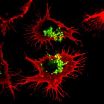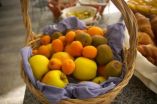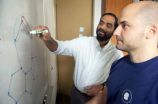Voluntary cooperation and monitoring lead to success
Economists provide field evidence on forest commons management
2010-11-12
(Press-News.org) FRANKFURT. Many imminent problems facing the world today, such as deforestation, overfishing, or climate change, can be described as commons problems. The solution to these problems requires cooperation from hundreds and thousands of people. Such large scale cooperation, however, is plagued by the infamous cooperation dilemma. According to the standard prediction, in which each individual follows only his own interests, large-scale cooperation is impossible because free riders enjoy common benefits without bearing the cost of their provision. Yet, extensive field evidence indicates that many communities are able to manage their commons, albeit with varying degrees of success. How do we explain this variation in management outcomes? How do different levels of cooperation emerge and what contributes to their success? The economist Prof. Michael Kosfeld examined these questions together with his colleagues Devesh Rustagi and Prof. Stefanie Engel from the Swiss Federal Institute of Technology (ETH) Zurich. The answer: The degree of voluntary cooperation together with the monitoring of free riders plays a key role in the success of commons management.
In their field study, details of which are published in the November 12 issue of the journal Science, the researchers analyzed a major forest commons management program launched to save the biodiversity rich Afro-montane ecosystem and the livelihood of the Bale Oromo pastoralists in Ethiopia. The team was particularly interested in the degree of conditional cooperation in a group. This means that group members are willing to cooperate voluntarily provided that others cooperate as well. Numerous behavioral experiments with student participants have shown that conditional cooperation plays a significant role in solving the dilemma of cooperation. However, so far no evidence exists which corroborates the relevance of conditional cooperation in the field with actual commons users. The researchers' objective was to provide exactly this evidence.
The economists conducted behavioral cooperation-experiments with 679 members from 49 different forest user groups in which they elicited the group members' willingness to cooperate voluntarily. They found that groups differ widely in their share of conditional cooperators, from 0 % to 88 %. In groups with lower share of conditional cooperators, free rider share was high. To examine how this impacts forest management success, the team ran a variety of statistical analyses which showed that groups with larger share of conditional cooperators were much more successful in managing their forests. The success of a group was determined by the number of trees of intermediate height per hectare. Trees of this kind are vital for the sustainable growth of the forest.
But why are groups with larger share of conditional cooperators more successful at forest management? To entangle this puzzle, the trio looked at the time spent by group members in monitoring their forest. They found that groups with higher share of conditional cooperators not only cooperate more but also monitor more by conducting patrols through the forest. Such patrols are important for the detection and deterrence of free riding. A group with 60 % conditional cooperators was likely to spend on average 14 hours more per month in monitoring than a group without any conditional cooperators. Devesh Rustagi, a post-doc at the Institute for Environmental Decisions, says "this finding is interesting, as it shows that conditional cooperators are willing to spend resources to detect individuals who free ride at their expense. It provides a behavioral link in explaining monitoring as a success mechanism in commons management".
"The results of our study provide first-time evidence that conditional cooperation which has been identified in many laboratory experiments before plays a key role in a concrete case of commons management in the field," explains Michael Kosfeld, Director of the Frankfurt Laboratory of Experimental Economics at Goethe-University. "Our findings fill a long-standing gap between field and laboratory studies on human cooperation."
The results also shed light on the evolution of human cooperation. They show a positive co-variation between conditional cooperation and costly monitoring. This is in line with the theory of gene-culture evolution, which predicts higher cooperation in groups where enforcement of cooperation is prevalent.
"The results yield important policy implications for the governance of human collective action", explains Rustagi. "Because humans differ in their motivation to cooperate, an effective solution to commons problems should not be based on incentives for purely self-regarding individuals alone but needs to explicitly take into account the complex interplay of heterogeneous motivations and behavioral norms to cooperate voluntarily".
Prof. Stefanie Engel from the Institute for Environmental Decisions at ETH Zurich concludes: "Given that the UN has declared 2010 as the year of biodiversity and 2011 the year of forests, the results may in fact open new doors to find solutions to commons problems, which house nearly 18% of the world's forests and a large share of biodiversity".
INFORMATION: END
ELSE PRESS RELEASES FROM THIS DATE:
2010-11-12
A new breakthrough in the fight against pneumonia, meningitis and septicaemia has been announced today by scientists in Dublin and Leicester.
The discovery will lead to a dramatic shift in our understanding of how the body's immune system responds to infection caused by Streptococcus pneumoniae and pave the way for more effective vaccines.
The collaborative research, jointly led by Dr Ed Lavelle from Trinity College Dublin and Dr Aras Kadioglu from the University of Leicester, with Dr Edel McNeela of TCD as its lead author, has been published in the international peer-reviewed ...
2010-11-12
For the first time, scientists have been able to "freeze in time" a mysterious process by which a critical enzyme metabolizes drugs and chemicals in food. By recreating this process in the lab, a team of researchers has solved a 40-year-old puzzle about changes in a family of enzymes produced by the liver that break down common drugs such as Tylenol, caffeine, and opiates, as well as nutrients in many foods. The breakthrough discovery may help future researchers develop a wide range of more efficient and less-expensive drugs, household products, and other chemicals. The ...
2010-11-12
DURHAM, N.C. – Tinkering with a single gene may give perennial grasses more robust roots and speed up the timeline for creating biofuels, according to researchers at the Duke Institute for Genome Sciences & Policy (IGSP).
Perennial grasses, including switchgrass and miscanthus, are important biofuels crops and can be harvested repeatedly, just like lawn grass, said Philip Benfey, director of the IGSP Center for Systems Biology. But before that can happen, the root system needs time to get established.
"These biofuel crops usually can't be harvested until the second ...
2010-11-12
STANFORD, Calif. — One protein single-handedly controls the growth of blood vessels into the developing brains of mice embryos, according to researchers at the Stanford University School of Medicine. Understanding how the protein, a cellular receptor, functions could help clinicians battle brain tumors and stroke by choking off or supplementing vital blood-vessel development, and may enhance the delivery of drugs across the blood-brain barrier.
"The strength and specificity of this receptor's effects indicate that it could be a very important target," said Calvin Kuo, ...
2010-11-12
Bethesda, MD—An original and progressive report on health information technology (HIT) vendors, their customers and patients, published online today, makes ground-breaking recommendations for new practices that target the reduction or elimination of tensions that currently mar relationships between many HIT vendors and their customers, specifically with regard to indemnity and error management of HIT systems. In light of the Obama Administration's $19 billion investment in HIT, paid out in ARRA stimulus funds, these recommendations are particularly significant in helping ...
2010-11-12
PROVIDENCE, R.I. [Brown University] — The website of the Nobel Prize shows a cat resting in a graphene hammock. Although fictitious, the image captures the excitement around graphene, which, at one atom thick, is the among the thinnest and strongest materials ever produced.
A significant obstacle to realizing graphene's potential lies in creating a surface large enough to support a theoretical sleeping cat. For now, material scientists stitch individual graphene sheets together to create sheets that are large enough to investigate possible applications. Just as sewing ...
2010-11-12
SANTA CRUZ, CA--A bulge of elevated topography on the farside of the moon--known as the lunar farside highlands--has defied explanation for decades. But a new study led by researchers at the University of California, Santa Cruz, shows that the highlands may be the result of tidal forces acting early in the moon's history when its solid outer crust floated on an ocean of liquid rock.
Ian Garrick-Bethell, an assistant professor of Earth and planetary sciences at UC Santa Cruz, found that the shape of the moon's bulge can be described by a surprisingly simple mathematical ...
2010-11-12
ANN ARBOR, Mich.---Strategies for preventing the spread of whooping cough---on the rise in the United States and several other countries in recent years---should take into account how often people in different age groups interact, research at the University of Michigan suggests.
The findings appear in the Nov. 12 issue of the journal Science.
Thanks to widespread childhood vaccination, whooping cough (pertussis) once seemed to be under control. But the illness, which in infants causes violent, gasping coughing spells, has made a comeback in some developed countries ...
2010-11-12
Boston, Mass. - While it has become clear in recent years that susceptibility to pain has a strong inherited component, very little is known about actual "pain genes" and how they work. In the November 12th issue of Cell, researchers at Children's Hospital Boston and their collaborators report on a novel human pain gene. People with minor variations in this gene showed clear differences in susceptibility to acute heat pain and chronic back pain. Corroborating mouse studies give some clues as to how the gene controls pain sensitivity. The gene was uncovered in a genome-wide ...
2010-11-12
Controlling and modulating the flow of light is essential in today's telecommunications-based society. Professor Tobias Kippenberg and his team in EPFL's Laboratory of Photonics and Quantum Measurements have discovered a novel way to couple light and vibrations. Using this discovery, they built a device in which a beam of light traveling through an optical microresonator could be controlled by a second, stronger light beam. The device thus acts like an optical transistor, in which one light beam influences the intensity of another.
Their optical microresonator has two ...
LAST 30 PRESS RELEASES:
[Press-News.org] Voluntary cooperation and monitoring lead to success
Economists provide field evidence on forest commons management



